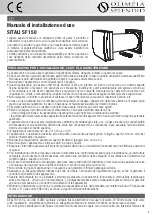
Midwest Industries, Inc. Ida Grove, IA 51445 800-859-3028
www.shorestation.com
0004405
Page 12 of 12
Rev B 11/05/2013
Positioning the PWC on the Hoist
The hoist is designed to raise and support the rated load as identified on the capacity labels on the hoist.
However, for optimum performance the PWC must be properly positioned on the hoist platform when it is being
raised. The hoist is designed to raise the load in the center of the load front to rear. The center of gravity of the
PWC load being raised should be aligned with the vertical posts.
Determining the Center of Gravity of the Machine
Many times the center of gravity of the machine will be located approximately at the center of the motor front to
rear. This will be close in determining the position of the machine on the hoist front to rear for most two and three
place machines. Four place machines may have the center of gravity located further rearward to approximately
the center of the machines length front to rear. These are good starting points for determining the center of gravity
on the standard machines. Moving your individual machine slightly forward or backward from here will get you
very close to the center of gravity. Once identified, place an identifying mark, tape or decal at that location on the
top outside edge of the PWC so you have a locating point to use when positioning the PWC on the hoist after use.
This is accomplished by placing the PWC on the hoist until the mark, tape or decal is located directly opposite the
vertical post.
Positioning the machine as described will reduce the internal friction and drag thus allowing your unit to be raised
with less strain and force.
SAFETY PRECAUTIONS
DO NOT OPERATE THIS HOIST WITHOUT FIRST STUDYING THIS OWNER’S MANUAL
1. See to it that you, your family, and anyone else who uses the hoist looks upon the unit not as a toy, but a piece
of heavy equipment that deserves your respect and good judgment.
2. Before allowing anyone to operate the unit, be sure they fully understand the proper operating procedure.
3. Do not exceed maximum capacity unit, overloading may cause mechanical failure and serious personal injury.
4. All persons should stand clear and should not be allowed to board your watercraft when it is being raised or
lowered.
5. If you choose to remove the winch cover and inspect or work on the winch, be sure the platform is completely
lowered.
6. It is a good safety policy to restrict children, as well as adults, from playing on or near the hoist.
7. Service winch annually.
IMPORTANT:
Winch maintenance schedule must be followed to avoid possible failure
and injury. See winch
owner’s manual for instructions.
8. Check cable for wear or fraying and also stress on cable attaching ends. If this occurs, replace cable
immediately.
9. Be sure the hoist is installed level, severe out of level installation may cause hoist hand up and serious
personal injury.
10. Do not work on you watercraft or hoist with watercraft on the hoist.
11. Check all sheaves, make sure they are turning and operating properly.
12. Check fasteners on cable ends to be positive they are threaded properly (see setting up instructions).
13. If the winch handle begins to freely spin down for any reason, at no time should you attempt to prevent it from
doing so. Such action could result in injury to arms and hands. Instead, simply let the platform spin down into the
water. Doing so will neither damage your watercraft or hoist.
14. Never pick up on platform of hoist while trying to move, position, or transport hoist. Doing so may cause
serious personal injury.
15. Never stand or walk on hoist platform while in any raised position. Doing so may cause serious personal
injury.





























